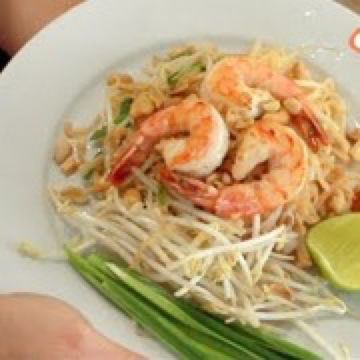- The Sauce
- 35 grams palm sugar, finely chopped (about 3 tightly packed tablespoons)
- ¼ cup tamarind concentrate (see note)
- 2 tablespoons fish sauce
- 3 tablespoons water
- Pad Thai
- 4 ounces dry rice noodles, (see note)
- 8–10 Shrimp, or as many as you’d like, peeled and deveined
- 1 small head shallot, thinly sliced, about 3 Tbsp
- 2 cloves garlic, chopped
- 1 tablespoon dried shrimp, chopped
- 1 piece pressed tofu, cut into small pieces
- ½ teaspoon chili flakes, or to taste
- scant ¼ cup chopped sweet preserved daikon radish
- 2 eggs
- 2-½ cups bean sprouts
- 1 cup garlic chives, cut into 2” pieces
- ¼ cup chopped roasted peanuts
- 1 lime
There is so much Westernized pad thai out there, few people actually know what real pad thai tastes like! Well, take it from a Thai person (me), it’s supposed to taste like this recipe Yes, there are many variations of pad thai out there, so of course this isn’t the only way to do it, but if you want to get to know the basic, original, classic flavour, this is the one.
ingredients
directions
1. Soak the rice noodles in room temperature water for 1 hour, until the noodles turn from translucent to completely white. Drain. You can soak the noodles in advance, drain, and store in a sealed container in the fridge until ready to use. |
2. Heat 2 Tbsp of oil over high heat in a wok or a large saute pan. When the pan is very hot, add the shrimp and let cook without moving until they are halfway done. Flip and finish cooking the shrimp on the other side. Remove and set aside. |
3. In the same pan, add another 1-2 tablespoons of oil. Add the shallots, garlic, dried shrimp, preserved radish, pressed tofu, and chili flakes. Cook until the garlic starts to brown. |
4. Add the noodles and the sauce, and keep stirring and tossing until the noodles have absorbed all the sauce. If you are using fresh pad thai noodles, you can do 1 of 2 things: 1) Blanch the noodles for 20-30 seconds in boiling water and drain well before adding them to the pan. 2) Add more water to the pan, about 1/2 cup, but add only 1/4 cup at a time and check the noodles consistency once all liquid has been absorbed. If they are still too chewy, add another 1/4 cup. You may need more or less than 1/2 cup. |
5. When all the sauce has been absorbed, push the noodles to one side of the pan and add the eggs. Scramble the eggs gently and let the eggs set about half way. Put the noodles on top of the eggs and let the eggs set completely for another 15 seconds or so. Flip the eggs over using a spatula and break up the eggs. |
6. Add the beansprouts, garlic chives, and half of the peanuts. Turn off the heat and toss just to mix. |
7. Plate the noodles, top with the shrimp and sprinkle over the remaining peanuts. Serve with a piece of lime, extra bean sprouts, garlic chives, and chili flakes. Make sure you squeeze that lime over the noodles before you enjoy! |
Notes
 Different brands of tamarind concentrate varies in acidity. So you may need to adjust this amount after making it the first time. Different brands of tamarind concentrate varies in acidity. So you may need to adjust this amount after making it the first time. If you are using fresh, uncooked rice noodles (see video) you will need to use about 5-6 ounces of noodles, and there is no need to soak them. |


